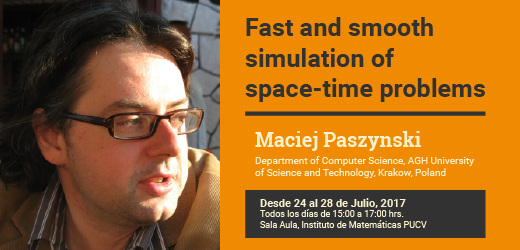Fast and smooth simulation of space-time problems
Desde el 24 de Julio, 2017 Hasta el 28 de Julio, 2017
Abstract
In this short course, we present a parallel solver for the solution of non-stationary problems in one, two or three dimensions. The software utilizes isogeometric finite element method, namely the tensor product B-spline basis functions for spatial discretization. The software also uses fast alternating direction solver resulting in a linear computational cost of the factorization of the system of equations generated during the simulations. The software uses either explicit or implicit time discretization methods. We have prepared the solver framework in a way that it enables for direct implementation of the selected PDE and corresponding boundary conditions. In this course, we first introduce the numerical method, describe the installation, implementation of exemplary three PDEs, and execution of the simulations on multi-core Linux cluster nodes. We consider four case studies, including heat transfer, non-linear flow in heterogenous media, elastic wave propagation and the simulation of the pollution from a chimney. The presented package generates output suitable for interfacing with Gnuplot and ParaView visualization software. The presented software requires C++ compiler, cmake, boost, and two numerical libraries, LAPACK for matrix processing and GALOIS for parallelization. During the course, we go through the installation procedure.
Organiza y Financia:
Proyecto MEC PAI80160025 (CONICYT) “Direct Solvers & Parallel Computing @Valparaíso”
Instituto de Matemáticas – PUCV
Información, Contacto y Registro de Participantes:
Ignacio Muga
ignacio.muga@pucv.cl
Program
Day 1.Introduction to isogeometric finite element method and alternating direction solver
This lecture presents basic definitions of concept utilizes in isogeometric finite element method, including B-splines, knot vectors, and knot points. It also presents how to perform finite element approximation of a given function with B-splines by formulating and solving L2 projection problem with Galerkin method. Finally, it shows how to transform time dependent problem into a sequence of isogeometric L2 projections. It also shows how to exploit the Kronecker product structure of the mass matrix build from tensor product B-spline basis functions in order to get a linear computational cost of the factorization.
Day 2. Installation of the software on the virtual machine
This is the lab where we install the virtual machine driver on laptops, download the GALOIS framework, boost, and cmake, and finally compile our IGA-ADS software on top of it. We will also run a simple heat transfer simulation and generate Gnuplot and Paraview movies out of it.
Day 3. Examples of the usage of the parallel explicit solver
We will change the IGA-ADS solver code in order to be able to run the simulation of the non-linear flow in heterogeneous media. I will also explain the details of the problem, that is of the great interest to oil industries since it models the hydraulic fracking process.
We will also discuss a parallelization of loops with GALOIS and check its efficiency.
Day 4.
This lecture presents how to perform the alternating direction splitting for the Laplace operator, for the advection term, and for the linear elasticity term. It shows how the direction splitting allows obtaining unconditionally stable time integration scheme that results in a linear computational cost of the solver under to assumption of tensor product structure of the basis functions.
Day 5.
This lab presents how to transform the explicit simulation with heat transfer problem into an implicit simulation. This is done by reimplementing the Kronecker product structure of the matrix for the direction splitting of the Laplace operator and adjusting the time step size. We will check experimentally the gain in terms of the time step size.
4 Semestres
Más información
4 Semestres
Más información
4 Semestres
Más información
8 Semestres
Más información
8 Semestres
Más información



